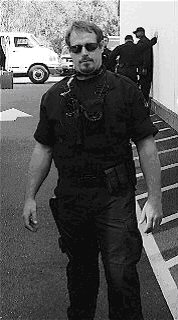Rory Miller is a former corrections officer and author of the acclaimed book “Meditations on Violence”. In it he explains his views on violence and training to prepare for it in detail. It’s a great read, packed with solid information and on my review list. I finished preparing the interview with Rory yesterday and here’s part 1. I’ll put part 2 on line later this week. Enjoy!
Q: Can you give a little background on your martial arts and self-defence training?
A: Sure. I started in judo in 1981 and loved it. Judo was my baseline for a long time but I dabbled in everything I could- karate, TKD, eclectic stuff, collegiate fencing, medieval European weapons. About 1987 I had just moved to Portland and was looking for a judo dojo and stumbled into Dave Sumner’s Sosuishitsu-ryu jiujitsu dojo. I was hooked. He was an amazing teacher and the ryu was simply the most brutal system I had ever seen. I stuck with Dave until he retired.
Alongside all this, when I turned 21 I got a job as casino security in Reno- a bouncer. That was a first taste that there was more to this combat stuff than I was learning in the dojo. Later, I joined the local Sheriff’s Office as a Corrections Officer. That was where the rubber really hit the road. By the time I left I had seventeen years in; was a sergeant, a tactical team leader and was teaching and designing classes on everything from how to talk crazy people down and how to take violent people down to first aid. It turns out I have a talent for dealing with violent and crazy people.
Q: What got you started in martial arts? Was there a triggering event?
A: Not an event. I grew up outside of a town with 210 people. I graduated from a class of six seniors. I’d heard of martial arts, read about them- in the seventies they were considered the way to become a complete person. When I went to college at the tender age of seventeen, I desperately wanted to do MA and was completely ignorant. It is only luck that my first two instructors were world-class competitors with a zero bullshit tolerance.
Q: Was your focus always self defense?
A: No. At first it was about pushing the limits of what my body could do. That little town was far more violent than most big cities and I never confused martial arts with self-defense. The transition to self defense (and I’m not sure that is quite the right word) arose out of the exposure to real violence.
Then when I got tapped to teach rookie officers I had to go really deep into why things worked. I’ve consistently made small joint locks work on threats who were much bigger and stronger than I was and fighting as hard as they could- ‘fully resistant opponents” in MMA parlance. I’d heard other people, with the time in training that I had and usually bigger say that it was impossible. I had to figure out how I made things work.

Q: How did you go about figuring this out? And what were your conclusions from researching it?
A: A lot of back engineering. Writing reports gave a lot of practice in clearly explaining what I did. Then looking at times when it didn’t work and people who had trouble making anything work. It actually turned out to be a pretty short list, maybe twelve items, that I keep combining and narrowing down- maximize leverage; really understand balance; two-way action; use gravity; exploit momentum… a lot of things that get lip-service in the martial arts but not many people seem to understand. At least not on the level that it takes to be able to improvise when things go bad.
Take centerline theory (which isn’t one of my core principles). Several people have explained it to me, “All your vital targets are on the centerline, so you must be able to attack his and defend yours.” That’s horse shit- the ears, the brachial plexus, the liver, the elbow, the knees, the fragile bones in the back of the hand, the quadriceps insertion are all good targets and all are off the centerline. That doesn’t mean the theory is crap, the understanding of the theory is crap. You strike towards the center of the body to use the weight as tamping, like in demolition- the bodyweight keeps damage from bleeding off into space.
From that perspective the centreline isn’t the middle front of the body, it is inside and when you are hitting lateral targets you are still striking towards the centerline. Some people use centerline as a quick ranging tool by measuring centerline to centerline, but when you keep the off line targets in mind you can do disabling kicks in a tight clinch and sometimes damaging handstrikes at long kicking range.
The other things that made stuff work were mental. Jointlocks, for instance, work for me for very specific reasons- I don’t try them if they aren’t going to work; if they start to fail I switch to something else immediately; and I apply them faster and more ruthlessly than anyone I know.
Q: How has your own training evolved since you started all those years ago?
A: I started as a classic MA junkie. I was skipping classes to train, dropping in on classes at the university I wasn’t registered for- I was regularly training two hours in the morning and four at night in scheduled classes and working out obsessively on my own. I got really shitty grades, by the way. There were a lot of transitions- from learning everything I can to working out the principles to stripping my personal skills down for effect and versatility. The last couple of years have been trying to figure out exactly what I have. I’m not sure it can be called a martial art anymore. Almost like it has been internalized, no longer something I do but part of who I am.
Q: Would you say this internalizing is a result of your training, your exposure to violence in the field, both or something else?
A: I really don’t know. Without the hard early training there would have been nothing to internalize. Without the experience it’s probable that I would have been a garden-variety martial artist, believing anything an ‘expert’ said and creating my own little fantasy world. The big question is why I haven’t burned out (much) and become completely disillusioned (much).
Q: Why do you think that is?
A: One word? Kami. No matter how dark the world gets or what I see or hear, she is always there. She has loved me when I was bleeding and the pepper spray wasn’t all washed off; held me when I only wanted to sit in the darkness and rock and hum until my head was empty. Knowing that no matter how much evil I see I can go home and KNOW that on balance the world is a good place makes everything else possible. Every thug needs a princess.
Q: How did the MA/SD world evolve over the years since you started? What are the good and bad evolutions you see?
A: I’m not sure evolved is the word. The majority of practitioners have always been fad-chasers. Most of the changes I have seen have been fads, nothing more. Judo was “it” in the 40’s and 50’s; then karate in the 60’s. TKD and some kung fu in the 70’s; ninja in the 80’s; MMA in the 90’s and RBSD at the turn of the millennium. There were a few other minor crazes in there.
If you track this, the same personalities that used to say (this came up the other day and I had to laugh) “a boxer could never beat a karateka” in the sixties are exactly like the people saying, “A karateka could never beat a boxer” today. Both points are absurd, but I find people’s ability to justify what they want to believe and make absolute pronouncements infinitely entertaining.
There are two trends that I think are very good things. One is the growth of MMA. It’s not self-defense and has nothing to do with that (get over it, people) but it is the current state of a long evolution of trying to test yourself as deeply and broadly as possible.
The second is the internet. It has allowed some very specialized people to contact each other. I consider less than 5% of martial artists to be serious. The real meat eaters in law enforcement are even more rare. The number of people that are both make for a very small handful. Locally I know exactly two. The ‘net has allowed me to meet some more from all over the world. That’s good. For me, anyway.
That’s it for the first part. Here’s the second part.
UPDATE: Check out my review of “Meditations on Violence”.
.



Leave a Reply